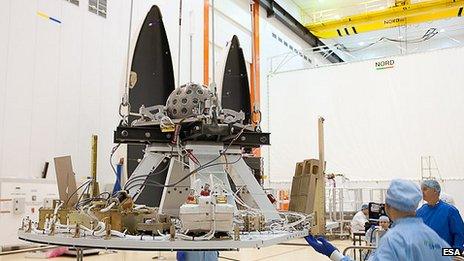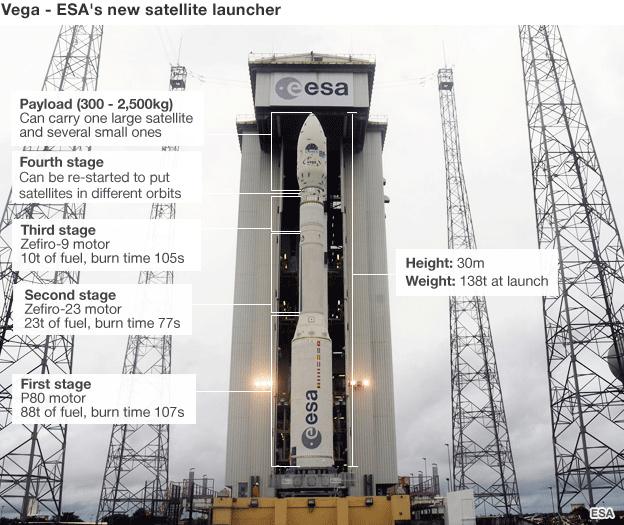Vega launcher makes first flight
- Published
Europe's new Vega rocket has completed a flawless first flight.
Controllers at the Kourou spaceport in French Guiana ignited the rocket at 07:00 local time (10:00 GMT), and it completed its mission 70 minutes later.
The 30m-tall vehicle has been designed to put small scientific and government satellites in orbit.
For its first outing, Vega carried nine payloads into space, including a physics experiment to test Einstein's theory of general relativity.
"A new member of the launcher family has been born," said Jean-Jacques Dordain, the European Space Agency's (Esa) director general.
Member states of Esa, together with their industries, are investing more than a billion euros in the introduction of Vega.
The vehicle is intended to guarantee access to space for an increasingly important class of satellite weighing less than 2.5 tonnes.
At the moment, these smaller spacecraft, which include many Earth observation satellites, tend to ride decommissioned Russian nuclear missiles to get into orbit.
European operators can sometimes wait many months to get a launch slot on these converted ICBMs, however.
Vega should allow them to have more control over the schedules of their space projects. It also means that the value of what it is an immensely high-tech enterprise will return to the European economy, not to foreign industry.
Vega is a four-stage rocket. Its first three segments burn a solid fuel. Its fourth and final stage uses liquid propellants and can be stopped and restarted several times to get a spacecraft into just the right orbit.
The stage can also bring itself out of the sky - something deemed very important these days given the rising concern over space debris.
Monday's mission was intended to qualify the overall Vega system, including the rocket vehicle itself and all its ground infrastructure and operations systems.

The Lares sphere was one of nine satellites riding on Vega
The largest satellite carried by Vega was the Lares (Laser Relativity Satellite) spacecraft. Developed by the Italian space agency (Asi), this 400kg payload looks akin to a hi-tech "disco ball".
The 37cm-diameter tungsten sphere features 92 reflectors on its surface that will be used to make very precise laser ranging measurements from Earth.
Lares' purpose is to study one consequence of general relativity known as "frame-dragging". This phenomenon, also referred to as the Lense-Thirring effect, describes how the Earth twists local space-time around with it as it rotates.
Lares was successfully released into a 1,450km-altitude circular orbit some 55 minutes into the flight.
The other eight satellites were ejected 15 minutes later. They are all very much smaller than Lares - most of them weighing just a kilo or so.
These university-produced payloads include the first ever spacecraft from Poland, Romania and Hungary.

Vega will lift off from a refurbished pad formerly used by the Ariane 1
Its four stages and satellite payload are assembled on the launch site
Satellites will weigh from a few 10s of kg up to a maximum of 2,500kg
The "reference mission" is a 1.5t satellite in a 700km-high polar orbit
Jonathan.Amos-INTERNET@bbc.co.uk and follow me on Twitter, external
- Published12 February 2012
- Published9 January 2012
- Published18 October 2011
- Published25 June 2011
- Published18 March 2011